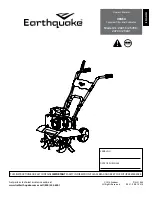
The EXV test can be repeated
by pressing
may be due to out-of-calibration
or inter-
mittent connections between processor board
a n d
plug. Recheck all wiring
voltage signals.
Other possible causes of improper
flow
control could be restrictions in liquid line. Check
plugged filter drier(s), stuck liquid line solenoid
or restricted metering slots in the EXV. Formation of ice
or frost on lower body of electronic expansion valve is
one
symptom of restricted metering slots. Clean or
replace valve if necessary.
NOTE: Frosting of valve is normal during compressor
Quick Test steps and at initial start-up. Frost should
dissipate after 5 to minutes operation of a system that is
operating properly. If valve is to be replaced, wrap valve
with a wet cloth to prevent excessive heat from damaging
internal components.
EXV OPERATION
These valves control the flow of
into the cooler. They are operated by
the
to maintain
degrees F of superheat
between the cooler entering refrigerant thermistor and the
lead compressor entering gas thermistor (located between
the compressor motor and the cylinders). There is one
EXV per circuit. A cutaway drawing of valve is shown
in Fig.
4 -STEPPER MOTOR
3 -LEAD SCREW
2 -PISTON
-ORIFICE ASSEMBLY
Fig.
Expansion Valve
High-pressure liquid refrigerant enters valve through
bottom. A series of calibrated
have been machined
in side of orifice assembly.
As
refrigerant passes through
orifice, pressure drops and refrigerant changes to a
phase condition (liquid and vapor). To control
flow for different operating conditions, piston
moves up and down over orifice, thereby changing
size. Piston is moved by a linear stepper motor. Stepper
motor moves in increments and is controlled directly by
processor module. As stepper motor rotates, motion is
into
movement by lead screw. Through
motor and
screws,
discrete steps of
obtained. The large number of steps and long
control of refrigerant
B e c a u s e
module, it is
to track
During
initial start-up, EXV is
start-up,
position is tracked by processor by constantly
amount of valve
The processor keeps track of the EXV position by
counting the number of open and closed
it has
to each valve. has no direct
feedback of valve
position. Whenever the unit is switched from STANDBY
to
both valves
be
This
the
processor will send enough closing pulses to the
to
move it from
open to fully closed and then reset the
position counter to zero.
The EXV open Quick Tests will send enough pulses to
the valve to drive it from fully closed to fully open. The
position of the
at the start of the test has no effect
on the number of
sent.
In the
the EXV close Quick Tests will
send
valve to drive it from fully
open to fully closed,
When the EXV opens, the metering slots are not
uncovered until step
This is fully closed position
when
circuit is operating. The fully open position is
760
T h e
subfunction shows the EXV valve
positions. They should
constantly while the unit
operates. If a
should stop moving for any reason
(mechanical
electrical) other than a processor or
thermistor failure. the processor will continue to attempt
to open close the valve to correct the superheat. Once
the calculated valve position reaches
(fully closed)
or
(fully open) it will remain there. If the EXV posi-
tion reading remains at 160 or 760 and the cooler and
compressor refrigerant thermistor displays are reading
the measured temperature correctly, the EXV is not
moving. Follow the EXV checkout procedure to deter-
mine the cause.
The EXV is also used to limit cooler suction tem-
perature to 55 F (13 C). This makes it possible for the
chiller to start at higher cooler water temperatures with-
out overloading compressor. This is commonly referred
to as MOP (maximum operating pressure).
21
Summary of Contents for HS070-160
Page 27: ......








































